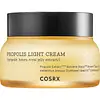What's inside
What's inside
 Key Ingredients
Key Ingredients

 Benefits
Benefits

 Concerns
Concerns

 Ingredients Side-by-side
Ingredients Side-by-side

Water
Skin ConditioningGlycerin
HumectantUrea
BufferingCaprylic/Capric Triglyceride
MaskingStearyl Alcohol
EmollientCetyl Alcohol
Emollient1,2-Hexanediol
Skin ConditioningLonicera Japonica Flower Extract
Skin ConditioningPolyglyceryl-3 Methylglucose Distearate
EmulsifyingCetyl Ethylhexanoate
EmollientSorbitan Olivate
EmulsifyingGlyceryl Caprylate
EmollientPalmitic Acid
EmollientButylene Glycol
HumectantOzokerite
Emulsion StabilisingHydrogenated Vegetable Oil
EmollientStearic Acid
CleansingArginine
MaskingCarbomer
Emulsion StabilisingBeeswax
Emulsion StabilisingStearyl Stearate
EmollientHydrogenated Palm Acid
Myristyl Alcohol
EmollientLauryl Alcohol
EmollientMyristic Acid
CleansingLauric Acid
CleansingOleic Acid
EmollientEthylhexylglycerin
Skin ConditioningWater, Glycerin, Urea, Caprylic/Capric Triglyceride, Stearyl Alcohol, Cetyl Alcohol, 1,2-Hexanediol, Lonicera Japonica Flower Extract, Polyglyceryl-3 Methylglucose Distearate, Cetyl Ethylhexanoate, Sorbitan Olivate, Glyceryl Caprylate, Palmitic Acid, Butylene Glycol, Ozokerite, Hydrogenated Vegetable Oil, Stearic Acid, Arginine, Carbomer, Beeswax, Stearyl Stearate, Hydrogenated Palm Acid, Myristyl Alcohol, Lauryl Alcohol, Myristic Acid, Lauric Acid, Oleic Acid, Ethylhexylglycerin
Propolis Extract
Skin ConditioningButylene Glycol
HumectantGlycerin
HumectantCaprylic/Capric Triglyceride
MaskingHelianthus Annuus Seed Oil
Emollient1,2-Hexanediol
Skin ConditioningHoney Extract
HumectantRoyal Jelly Extract
Skin ConditioningHydroxyethyl Acrylate/Sodium Acryloyldimethyl Taurate Copolymer
Emulsion StabilisingCassia Obtusifolia Seed Extract
Skin ConditioningCetearyl Olivate
Beeswax
Emulsion StabilisingCetearyl Alcohol
EmollientSorbitan Olivate
EmulsifyingAllantoin
Skin ConditioningArginine
MaskingCarbomer
Emulsion StabilisingXanthan Gum
EmulsifyingPropolis Extract, Butylene Glycol, Glycerin, Caprylic/Capric Triglyceride, Helianthus Annuus Seed Oil, 1,2-Hexanediol, Honey Extract, Royal Jelly Extract, Hydroxyethyl Acrylate/Sodium Acryloyldimethyl Taurate Copolymer, Cassia Obtusifolia Seed Extract, Cetearyl Olivate, Beeswax, Cetearyl Alcohol, Sorbitan Olivate, Allantoin, Arginine, Carbomer, Xanthan Gum
 Reviews
Reviews

Ingredients Explained
These ingredients are found in both products.
Ingredients higher up in an ingredient list are typically present in a larger amount.
1,2-Hexanediol is a synthetic liquid and another multi-functional powerhouse.
It is a:
- Humectant, drawing moisture into the skin
- Emollient, helping to soften skin
- Solvent, dispersing and stabilizing formulas
- Preservative booster, enhancing the antimicrobial activity of other preservatives
Arginine is an amino acid that is important for human development. Your body uses is it to produce hair keratin and skin collagen.
As a cosmetic ingredient, Arginine has antioxidant properties and can also help repair damaged skin. This ingredient is derived either synthetically or from animals.
Arginine isn't fungal acne safe when used in the presence of other lipids (fats, fatty acids, oils, esters, etc). Oils and fats occur naturally within the skin, so take caution when using Arginine if you're prone to fungal acne.
Learn more about ArginineBeeswax is natural wax produced by honey bees and can be synthetically created. It consists mainly of fatty acid esters and long-chain alcohols.
In cosmetics, beeswax is a emollient. Due to its waxy structure, it creates a protective barrier. This barrier prevents water from evaporating off the skin.
This may not be a good ingredient for oily skin. We recommend speaking with a professional if you have concerns.
Beeswax cannot be removed with water, but can be taken off with an oil cleanser.
Beeswax is also antiseptic and contains vitamin A.
Learn more about BeeswaxButylene Glycol (or BG) is used within cosmetic products for a few different reasons:
Overall, Butylene Glycol is a safe and well-rounded ingredient that works well with other ingredients.
Though this ingredient works well with most skin types, some people with sensitive skin may experience a reaction such as allergic rashes, closed comedones, or itchiness.
Learn more about Butylene GlycolThis ingredient is an emollient, solvent, and texture enhancer. It is considered a skin-softener by helping the skin prevent moisture loss.
It helps thicken a product's formula and makes it easier to spread by dissolving clumping compounds.
Caprylic Triglyceride is made by combining glycerin with coconut oil, forming a clear liquid.
While there is an assumption Caprylic Triglyceride can clog pores due to it being derived from coconut oil, there is no research supporting this.
Learn more about Caprylic/Capric TriglycerideCarbomer is a polymer of acrylic acid. Its main role is to create a gel consistency.
A high amount of carbomer can cause pilling or balling up of products. Don't worry, most products contain 1% or less of carbomer.
Glycerin is already naturally found in your skin. It helps moisturize and protect your skin.
A study from 2016 found glycerin to be more effective as a humectant than AHAs and hyaluronic acid.
As a humectant, it helps the skin stay hydrated by pulling moisture to your skin. The low molecular weight of glycerin allows it to pull moisture into the deeper layers of your skin.
Hydrated skin improves your skin barrier; Your skin barrier helps protect against irritants and bacteria.
Glycerin has also been found to have antimicrobial and antiviral properties. Due to these properties, glycerin is often used in wound and burn treatments.
In cosmetics, glycerin is usually derived from plants such as soybean or palm. However, it can also be sourced from animals, such as tallow or animal fat.
This ingredient is organic, colorless, odorless, and non-toxic.
Glycerin is the name for this ingredient in American English. British English uses Glycerol/Glycerine.
Learn more about GlycerinSorbitan Olivate is created from the fatty acids in olive oil and sorbitol.
This ingredient is an oil in water emulsifier. It helps stabilize a product by preventing oils and waters from separating. Sorbitan Olivate also helps hydrate the skin.
Manufacturers sell sorbitan olivate under the name OliveM 1000. OliveM 1000 a multifunctional ingredient. It is self-emulsifying. According to a manufacturer, OliveM 1000 does not disrupt natural skin biome.
Due to its olive oil base, this ingredient may not be fungal-acne safe.
Learn more about Sorbitan Olivate